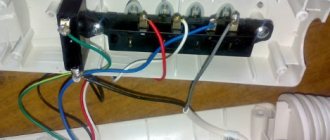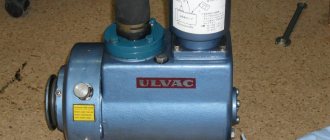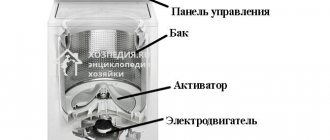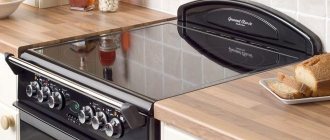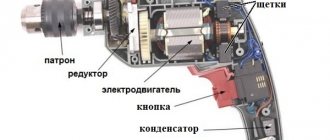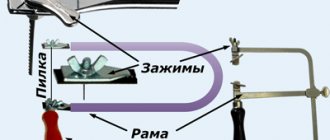Greetings! In this video I will show and tell you how a pneumatic impact wrench works. More precisely, I will show what is inside the tool. Probably many people like to learn the principles of operation, or even just disassemble something - for the sake of interest. This video is especially for you! I’ll tell you about the principles of operation, what it does and what it’s responsible for. How it works in practice. In general, take a look - it will be interesting! And as usual: like if you liked the video, comment, ask if something was not clear. And don't forget to subscribe to my channel if you haven't already. Enjoy watching!
Link to this video:
Practice using a wrench:
In modern auto repair shops and in many industries you can find a tool for working with threaded connections - a pneumatic impact wrench. Read the article about what a pneumatic impact wrench is, what types it is, how it is designed and works, as well as about the selection of a tool and its correct use.
What is a pneumatic impact wrench
A pneumatic impact wrench (pneumatic impact wrench) is a manual pneumatic thread-wrapping machine designed for tightening and disassembling fasteners of threaded connections (nuts, bolts).
Pneumatic tools are used in the repair and maintenance of vehicles, as well as in various branches of mechanical engineering. The popularity of pneumatically driven tools is explained by its advantages:
- Simple design;
- High efficiency;
- Easy to use.
A pneumatic impact wrench is simpler than an electric one, which ensures its high reliability, durability and maintainability. A tool with a pneumatic drive, with a compact size, develops high forces that are practically unattainable for a power tool of the same dimensions. On the other hand, this tool requires a source of compressed air, but all these costs are offset by the reduction in time and effort to complete complex work.
To make the right choice of a pneumatic impact wrench, you need to understand the design, types and features of the tools in this group.
Pneumatic impact wrench 1″ 3390 Nm 282 l/min. (heads 27-41mm) long shaft 9 ave. ROCKFORCE
Pneumatic impact wrench 1/2″ 678 Nm 10000 rpm. 158l/min. 90PSI shock JTC
Pneumatic impact wrench 1/2″ 1356Nm 6500rpm. drum JTC
Pneumatic impact wrench 1/2″ 720 Nm 7000 rpm. with heads 10-24mm 12 pieces EUREKA
Pneumatic impact wrench 1/2″ 624Nm 8000rpm. 220l/min. drum JTC
Pneumatic impact wrench 1/2″ 813 Nm 8000 rpm. 120l/min. ROCKFORCE
Pneumatic impact wrench 1″ 4800 Nm 3000 rpm. EUREKA
Pneumatic impact wrench 1″ 4800 Nm 3000 rpm. long shaft EUREKA
Pneumatic impact wrench 3/4" 1491 Nm 7250 rpm. 300l/min. shock reinforced JTC
Pneumatic impact wrench 1″ 3200 Nm long shaft EUREKA
Types, design and principle of operation of pneumatic impact wrenches
In general, pneumatic impact wrenches have a simple design. The basis of the tool is a housing in which the air motor and control elements are located (switch, reverse mechanism, and sometimes an engine speed controller). A shock-pulse or ratchet mechanism is attached to the body; the spindle head is located at their front end. In the body (handle or other place) there is a fitting for connecting the tool to the pneumatic line, next to it there is an outlet with a muffler (reduces the noise level during operation).
Pneumatic impact wrenches are rotary-action machines: the tool is based on a pneumatic motor that converts compressed air pressure into rotation of the working body. Impact wrenches are equipped with rotary vane (blade) motors. The pneumatic motor consists of a rotor in which movable flat blades (five or six pieces) are installed, and a fixed body. The rotor is located eccentrically in the housing, the blades rest against the inner walls of the housing. The housing has inlet and outlet windows. The operation of a pneumatic motor comes down to the following: compressed air, trying to expand, pushes the blades, forcing the shaft to rotate - this rotation is supplied to the working element or intermediate mechanism.
Pneumatic tools can be equipped with two types of engines: reversible and non-reversible (right and left rotation). The most modern and convenient solution is a reversible air motor, which can rotate in any direction. A wrench equipped with such a motor has a reverse mechanism to change the direction of rotation of the rotor. And to supply air to the engine, a pneumatic trigger switch located on the handle of the tool under the operator’s index finger is used.
Having one type of drive, impact wrenches are divided into two large groups:
The most common are impact wrenches - tools of this type are equipped with shock-pulse torque converters that transmit torque from the air motor to the working element. The shock-pulse converter operates in two modes:
- Direct transmission of torque from the motor to the working element;
- Transmission of torque and creation of shock (impulse) load on the working body.
In the first case, the shock-pulse converter acts as a conventional coupling connecting the motor rotor to the spindle of the impact wrench - this is how the mechanism works at the initial moment of screwing and after the nut comes off, when the tightening torque in the threaded connection is minimal. When the tightening torque increases (after the nut or its stop is broken off into a stationary part), the converter switches to impact mode - a series of shock pulses are supplied to the impact wrench spindle, which increase the instantaneous torque on the nut by 200-300 times, and ensure its tight or confident tightening breakdown
How to choose the right air impact wrench?
In accordance with the degree of intensity of future work, a household or professional pneumatic impact wrench is selected. A professional-grade tool suitable for everyday work. Household, “DIY” (“do it yourself”) class require use 1-2 times a week.
To choose the right tool, you should pay attention to three main parameters:
Specifications:
- Idle speed is the main criterion according to which the power of the equipment is selected. Experts recommend purchasing a tool within 3 thousand. – 7 thousand revolutions per minute;
- torque – determines the strength of the device. The construction markets offer impact wrenches with torque values from 500 Nm to 6000 Nm. The optimal value of this indicator is considered to be 3000 Nm. For work at passenger car service stations, 1500-2800 Nm will be just right;
- air flow is especially important when selecting a pneumatic impact wrench for a specific compressor for a car service. Here you need to take into account that the receiver may be too small to provide the instrument with the required volume of air. This may result in power losses. Standard models with a torque of 500-900Nm will consume within 140 liters per minute. When working with a wrench, you should try not to exceed the pressure (normal pressure is up to 6 bar).
Design features:
- the presence of reverse is necessary not only for the process of tightening, but also for unscrewing. Since the reverse is the most fragile part of the impact wrench, you should choose a future device from European-made models, which will last much longer than models of Iranian or Chinese origin;
- The tightening regulator is an expensive thing, so you should only look for a wrench equipped with a regulator if you really need it in the future. As a rule, tightening is carried out “by eye”. This gives an average error of 20%, which will not significantly affect the quality of work. You can also adjust the tightening torque by changing the volume of compressed air pressure at the inlet;
- square size - in any type of tool, this indicator is proportional to its power and often does not require any upgrades. The optimal value is ½ inch, and with high power devices - 1 inch;
- angular head - the need for it directly depends on the type of task at hand. An angle wrench will allow you to tighten bolts or nuts on the side surfaces. They are more compact and have minimal tightening torque. The cost of such an air impact wrench will be an order of magnitude higher, so you should think twice before purchasing an angular type of tool.
Appearance and ease of use:
- overall weight - too light a tool is not always good. Under heavier loads, lightweight equipment clamps the bolts weaker and rotates more;
- volume – you can select less. After all, even with special adapters, tightening nuts in hard-to-reach places will be extremely difficult. The main thing is that for small volumes, the impact wrench should be equipped with a side handle, which allows you to increase the tightening force and comfortably hold the tool in your hands;
- anatomical handles or specialized rubber pads - you can’t do without them when working in winter. This is especially true for tire fitting work. In cold weather, the body of the device may become slippery and fall out of your hands. This may cause equipment damage.
Characteristics of pneumatic impact wrenches
Among the characteristics of the pneumatic impact wrench, the connecting size of the head, the maximum size of the nut/bolt, the developed torque, the engine speed and the minute consumption of compressed air should be noted.
Most impact wrenches are equipped with a spindle with a square socket head. The square sizes correspond to the standard range: 3/8, 1/2, 3/4, 1 and 1½ inches. Structurally, the squares do not differ from similar devices on manual keys. At the same time, the maximum size of the fastener with which the tool can work lies within approximately the same limits (the maximum permissible size of the fastener is 1.1-1.5 times larger than the connecting square).
The torque developed by the tool depends on the power (as well as on the connecting square; the higher the torque, the larger the size of the square). For small impact wrenches (with a 3/8-inch square) the maximum torque is in the range of 70-120 Nm. For medium power tools (1/2 and 3/4 inch squares), the torque can vary from 200 to 1500 Nm. And for the most powerful impact wrenches this figure can reach 2500-5500 Nm.
With the engine speed the situation is the opposite: for powerful tools it barely exceeds 3000-4000 rpm, for medium ones it can reach 6000-6500 rpm, and for small ones it can reach 10000-12500 rpm.
The air consumption of different types of tools, even of the same power, can vary significantly - from 65-70 l/min to 850-1100 l/min. On average, a wrench requires 200-500 liters of air per minute.
The characteristics presented here will help you make the right choice of tool.
Pneumatic impact wrench with adjustable torque
Most modern impact wrenches are equipped with a torque control feature. The main task of this function is to prevent fasteners from overtightening, thread or head breakage. Adjustment will be useful for tightening relatively small nuts and bolts with a high torque tool. The fasteners on the M8 will most likely be damaged if you tighten them with a tool without a regulator, with a maximum torque of 1000 Nm.
The principle of operation of an adjustable pneumatic impact wrench is to limit the supplied air, as a result of which the torque is reduced. For example: if you set mode number 3 on a Fubag pneumatic impact wrench at 900 Nm, its torque will drop to 450 Nm, which will allow you to confidently tighten the M14 fasteners. The number of modes on different instruments may vary, but on average there are from 3 to 5. Information about operating modes is indicated in the documentation supplied with the tool. Each individual device has its own characteristics of adjustable power.
Questions regarding the selection and operation of a pneumatic impact wrench
You should buy a pneumatic impact wrench based on the expected scope of work, the maximum size of the fastener and the characteristics of the available pneumatic equipment. It is important to understand that the larger the size of the fastener, the more powerful the tool should be, and the larger the connecting square of its spindle should be. You should also take into account the working conditions - direct impact wrenches are the most versatile, but sometimes angle and ratchet tools provide assistance. It is also necessary to take into account the performance of the compressor or station - if it is lower than the volume of air consumed by the impact wrench, then it will not be possible to work normally with such a tool.
And most importantly: in conjunction with pneumatic impact wrenches, it is allowed to use only special impact socket heads that can withstand shock and vibration loads. If necessary, you can use various kinds of extension cords (straight or cardan) and other auxiliary devices.
When operating the tool, you must comply with the established safety and labor protection requirements - only in this way will the work be effective and without injury.
Feeling the breath of winter, all motorists are thinking about replacing seasonal tires. And many of us, when buying winter tires, are faced with a difficult choice - “studded” or “Velcro”? Each type of tire has its own advantages and disadvantages, and choosing one over the other can be very difficult. In this article we will try to make this difficult choice.
Filling the tank with low-quality diesel fuel can damage the engine until it completely fails. Special auto chemicals—diesel fuel additives, which are described in detail in this article—help to minimize or eliminate the negative consequences of refueling with low-quality diesel.
Twice a year, all drivers ask one question - when to replace seasonal tires? In the spring, everyone wonders when to install summer tires, and in the fall they are looking for the moment when to install winter tires, and very often drivers make a mistake. Read this article about how to choose the optimal time to replace seasonal tires, and how to avoid making mistakes in this difficult matter.
Heaters and pre-heaters from the German company Eberspächer are world-famous devices that increase the comfort and safety of winter operation of equipment. Read the article about the products of this brand, their types and main characteristics, as well as the selection of heaters and preheaters.
The warm season, especially spring and summer, is the season for cycling, nature walks and family holidays. In the AvtoALL.RU online store you will find everything to make your vacation enjoyable and useful.
The May holidays are the first truly warm weekend, which can be usefully spent outdoors with family and close friends! The range of products from the AvtoALL online store will help you make your outdoor leisure time as comfortable as possible.
Design and principle of operation of a pneumatic impact wrench
In the figure below you can see in detail the device of a pneumatic impact wrench. The unit consists of the following elements placed in a durable metal case.
- High performance air motor.
- Impact mechanism.
- Alloy steel chuck (stop).
- Torque regulator and reverse.
- Start button.
- A fitting for connecting the hose from the compressor.
- Air valve.
Due to the lack of a motor, this unit is much lighter than its electric counterpart. And the torque of the impact wrench has high values - from 300 to 2200 Nm (Newtons per meter).
Inside the unit, there are 2 main power units, each of which is designed to operate in different modes. The first block is an air motor that transmits rotational motion to the tool head. The second block is the node that creates shock loads. The pneumatic drive rotates due to the passage of compressed air through it, supplied through a high-pressure hose from the compressor.
There are 2 channels in the device body. Each of them directs air in different directions relative to the turbine. In the first case, the air pushes the turbine clockwise, that is, to tighten it, and in the second case, counterclockwise, to unscrew the fasteners. Air flows are distributed by a special switch.
The operating principle of a pneumatic impact wrench is as follows.
- After pressing the start button, the valve opens and the air flow from the hose connected to the body of the apparatus begins to move through the turbine, rotating it.
- From the turbine, the rotational motion is transmitted to the impact mechanism, which in its principle of operation resembles a clutch. The mechanism contains 2 cams of complex configuration. The impact force is generated by the cams at the moment when there is not enough torque when releasing the fasteners.
- Next, the rotational movement is transferred to a stop (chuck), onto which a nozzle for a certain size of nut is placed. As a result, the fasteners are twisted or unscrewed. Some air impact wrenches do not use an impact mechanism when tightening; the process takes place in a non-impact mode.
- If the nut is stuck, it will take more effort to unscrew it, and at this moment the rotation of the stop stops.
- The hammers begin to lean back, turning at the same time.
- At the next stage, the cams bypass the engagement with the stop and, continuing to move, gain inertia.
- Continuing to rotate, the cams again engage with the stop and strike it (in the direction of movement).
- The shock pulses continue until the fastener “breaks” out of place.
Thus, with the help of a pneumatic impact tool, the process of unscrewing tight bolts and nuts is easy and quick.
Choosing a compressor for an air impact wrench
Many car enthusiasts, when buying a pneumatic impact wrench, wonder what kind of compressor is needed for this unit. First of all, you should pay attention to its performance according to the passport. There is one caveat here: some companies that produce compressors, in order to increase sales, indicate the performance not at the output, but at the input. For example, the documentation for the unit indicates its productivity of 210 liters per minute. This means that this indicator should be interpreted as the speed at which the compressor pumps air into itself, that is, into the receiver. At the end, productivity can drop by approximately 30-40%. And it turns out that the unit actually produces only 146-127 l/min.
Based on the above, it can be understood that if the compressor indicates a capacity of 210 l/min, then you need to choose a wrench with a significantly lower air stream speed. For example, if the operating speed of the air flow of the tool is 200 l/min, and the compressor according to the documentation is 210 l/min (in reality – 146-127 l/min), then you will not be able to unscrew anything with such a tool or tighten it properly.
In addition, the volume of the receiver also plays an important role. In household units, the cylinder can have a volume of only 24-50 liters. Under such conditions, the impact wrench will not work properly. Even with a receiver volume of 50 liters, after a few seconds of operation of the tool, the pressure in it decreases significantly, and to continue work you have to wait until it is restored. Therefore, the compressor receiver must have a volume greater than 50 liters, and the unit itself must create a pressure in it of at least 6.2 kg/cm². Otherwise, the device will not be able to develop the necessary power.
But the pressure in the system should not be allowed to be too high. Exceeding the recommended pressure has a detrimental effect on the main components of the tool, leading to rapid wear and, as a result, failure of the impact wrench.
The result of the above is this: if the tool is designed for an operating air speed of 119 l/min, and the compressor for the impact wrench produces 135 l/min in reality, then with its help you can unscrew and tighten fasteners on wheels without any problems. But do not forget that the tool must have a torque of at least 550 Nm.
Selection principles
The following are the main criteria for selecting a pneumatic impact wrench.
Specifications
The rotation speed of the rotor determines the operating speed. This parameter can reach up to 8000 rpm. When using devices with a large value, caution is required due to the difficulty of controlling the degree of tightening, which can lead to stripping of the thread, especially small fasteners. The rotor speed is adjusted by changing the compressor pressure. It is recommended to purchase a device with a rotation speed of 3000 rpm.
Torque determines the power of the impact wrench. With a small value, weak tightening occurs, and the fastenings quickly weaken under the influence of variable loads. Excessive torque leads to overstress in the thread, leading to its rapid destruction. The range of this parameter for impact wrenches is 30-6000 Nm, but for pneumatic models it is narrower (300-2200 Nm). For example, you should consider options with an indicator of 100 Nm when choosing for tire fitting. It must be taken into account that the declared torque value is achieved only in the main direction of rotation. Some devices are equipped with adjustments, usually including 3-5 modes. The principle of its operation is to limit the forced air, leading to a reduction in torque.
The spindle size is selected based on the fasteners used. Thus, for automotive parts, where fasteners with threads with a diameter of 25 mm predominate, a 0.5-inch spindle is required. An inch spindle is suitable for fasteners with a thread of 25-32 mm, a one and a half inch spindle is suitable for threaded diameters from 50 mm.
The characteristics discussed above are interrelated. Thus, high-speed impact wrenches are characterized by high torque, therefore, they are designed for large fasteners and are equipped with large spindles. It should be borne in mind that powerful tools require appropriate compressors and high costs, so purchasing them is not always advisable. In general, for constant work it is recommended to purchase a compressor with a power reserve of 40%.
When selecting a tool for an existing compressor, take into account the pressure and air flow of the impact wrench. If its needs exceed the compressor's performance, the full power of the tool is not achievable.
Design features
As noted, there are a number of additional devices for air impact wrenches.
Due to the pulsed rotational action, air impact wrenches are significantly superior in performance to conventional analogues. Firstly, they are able to dismantle tighter joints. Secondly, impact wrenches provide the required tightness of the connections created, eliminating the need for control tightening of fasteners.
The reverse significantly expands the functionality of the tool, allowing you to use the impact wrench for both dismantling and assembly, so its presence is also very desirable.
The torque regulator, on the contrary, is very expensive, so it is not always advisable, given that in most cases the tightening is carried out arbitrarily with an error of up to 20%. It is especially relevant when working with small fasteners on high-power models.
However, it must be taken into account that usually increasing the complexity of the design leads to a decrease in reliability.
An important factor in the functioning of an air impact wrench is compatibility with the compressor. It is determined by parameters such as operating pressure and air flow. This combination of equipment is considered optimal when the compressor exceeds the impact wrench by 2 times in operating pressure and by 1.2-1.3 times in air flow. For example, for a wrench with an air flow rate of 7.5 l/sec and a working pressure of 6 atm, in accordance with the above rule, a compressor with a capacity of 9 l/sec and a pressure of 8 atm is suitable. This ensures that the equipment meets the stated specifications and is reliable. Therefore, the power of the air impact wrench directly determines the required compressor efficiency. In this case, it is necessary to distinguish between the productivity of the latter at the input and output. Thus, some manufacturers provide an input value that determines the speed of air injection into the receiver. Output productivity is 30–40% lower. For example, with a stated value of 210 l/min, the compressor will pump air into the tool at a speed of approximately 140 l/min. In addition, the volume of the compressor receiver should be taken into account. This parameter determines the stability of the impact wrench. Thus, in small receivers of household compressors, the pressure immediately after the start of operation decreases significantly, which forces it to be suspended. Therefore, it is recommended to use a compressor with a pressure of 6.2 kg/cm3 and a receiver with a volume of 50 liters or more for the impact wrench. However, excessive pressure in the system is also unacceptable, as it leads to accelerated wear of the impact wrench.
In addition, the quality of the forced air is important. It is determined by parameters such as humidity and oil content specified in the instrument instructions. Insufficient air purification by lubricators and compressor filters will lead to rapid wear of the air impact wrench. In addition to the compressor itself, the features of the hose connecting it to the impact wrench are important. It should be taken into account that the standard hoses of most compressors with an internal diameter of 6 mm are not enough to connect to many pneumatic tools due to their low throughput. Hoses for gas equipment are considered very suitable.
Other parameters
In addition to how the impact wrench is designed and operational parameters, ease of use is of great importance, determined primarily by such parameters as dimensions and weight.
Based on the shape of the body, pneumatic impact wrenches are classified into pistol and cylindrical. The former are more convenient for holding in a horizontal position. The cylindrical shape is more suitable for vertical work, and the extended shaft makes it possible to work in hard-to-reach and recessed areas. Currently, the most common models are the first type.
In addition, there are corner models designed to work with fasteners from the side. Their handle represents the leverage arm. Such impact wrenches are convenient for specific cases, but for most jobs they are impractical to use due to their complicated design and higher cost.
As for the sizes, it is recommended to choose compact impact wrenches in case of work in hard-to-reach conditions.
In terms of weight, pneumatic impact wrenches are significantly inferior to electric models. For most options it is 0.75-4 kg. The weight of professional tools reaches 10 kg. The most modern impact wrenches with bodies made of composite materials are approximately 2 times lighter than conventional analogues. However, keep in mind that lightweight tools are not always the best. Thus, high-power models with low mass are difficult to hold.
Many models of impact wrenches are equipped with additional devices such as handles and pads. The latter are very useful when working in cold conditions, and also generally contribute to better retention. The presence of a side handle is especially important for compact tools to increase the tightening force.
In addition, the main features of air impact wrenches can significantly depend on the manufacturer. It should be taken into account that many little-known brands are characterized by overestimation of instrument performance. In general, it is recommended to purchase expensive European models.
Finally, it should be borne in mind that for a wrench as a specific tool, cost does not determine quality. The main selection criterion that determines all the parameters discussed above is the purpose.
Why does a compressor need a filter?
The air leaving the compressor must be clean, that is, free of various impurities that could damage the impact wrench. Not everyone knows that condensation forms in the internal space of the receiver during air compression. Also, oil may enter the receiver along with the forced air if the mechanical part of the unit is severely worn out. Oil, mixing with condensate (moisture), takes the form of an emulsion and enters the instrument through a hose connected to it. This emulsion can cause corrosion of all parts of the mechanical part of the unit. For this reason, service workshops often end up with impact wrenches filled with water and rust, with broken components.
In order not to bring the instrument to such a deplorable state, it is customary to install a filter-moisture separator on the compressor. Inside it there is a filter mesh made using special technology from bronze.
The air passing through the filter gives off moisture and loses all impurities that fall into the sump. Typically, the body of the dehumidifier is made of transparent material to monitor the amount of contaminants accumulated during operation.
The sump also has a valve (located at the bottom), through which all contaminants are easily removed.
The fact that the filter is dirty and does not provide the required air flow rate can be determined by a drop in the power of the tool. The impact wrench starts to work within normal limits in the first seconds, but then suddenly slows down and loses power. This fact is explained by the fact that the tool starts up due to the accumulated air in the hose, after which it becomes insufficient due to the low throughput of the clogged filter. In such cases, the filter is removed, washed in a solvent, and then thoroughly blown with air. In extreme cases, the filter has to be changed. It can be purchased at stores that sell pneumatic tools.
Hose selection
You should know that the hose that comes with the compressor, especially one made in China, is not suitable for the effective operation of the impact wrench. Most often, these hoses have an internal cross-section of about 6 mm. This hose capacity will not be enough to supply the required volume of air to the pneumatic tool. They can, perhaps, blow off dust, use them for a spray gun, but nothing more. Even inflating tires with it takes a lot of time.
Therefore, it is necessary to acquire another hose with greater throughput. Ideally, this could be a gas hose, which can be purchased at a gas equipment store. The marking (Propane-Butane) will be visible on it, as well as the maximum pressure that it can withstand and the value of the internal diameter.
Choosing oil for a wrench
The lubrication of this air tool should be taken with the utmost seriousness. If the unit can operate without purified air for some time, then without lubrication it will fail very quickly. The oil supplied to the moving parts of the device reduces friction between them and also removes wear products in the form of fine dust. This dust can fill the gaps between the blades and the rotor, which slows down their movement. As a result, the power of the tool is significantly reduced. The problem is solved by installing a lubricator into the system. The photo below shows its linear type.
But installing a “lubricator” will help extend the life of the impact wrench only if it is filled with a special lubricant intended only for pneumatic tools and having the required viscosity.
Try to purchase impact wrench oil that is recommended by the tool manufacturer. As a last resort, you should use only synthetic oil, which has good anti-wear and anti-corrosion properties and does not contain silicone.
It is impossible to pour transmission or engine oil into the lubricator, since it has a viscosity higher than required and successfully “sticks” the pneumatic drive blades, causing the unit to lose power.
Special lubricant can also be purchased from companies offering pneumatic tools.
Rules for applying lubrication
If for some reason you are unable to install a lubricator on your unit, then you can get out of the situation in the following way.
- Immediately before starting the impact wrench, you need to unscrew the hose from it and drop 3 to 5 drops of lubricant into the tool fitting.
- Next, you should return the hose to its original place and turn on the unit for a short time (thirty seconds will be enough). Thanks to this operation, the oil will be evenly distributed over all moving parts of the device.
Lubrication in this way must also be carried out before long-term storage of the tool. When using the unit in intensive mode, oil should be dripped into the fitting every 3-4 hours.
Although this method helps to extend the life of the impact wrench, it is very inconvenient. You have to interrupt work and spend time cleaning the tool from contaminants in the area of the fitting and preparing lubricant. Also, during the procedure, you should carefully ensure that no dust gets into the unit. It is for these reasons that it is recommended to install a lubricator in the system, which will always supply lubricant to the tool in a timely manner.
Lubricant for air impact wrench
The service life of any mechanical tool largely depends on the quality of lubrication of its parts. The easier the mechanism operates, the less wear will occur. If you want your impact wrench to serve you faithfully for many years, follow the basic rules for maintaining the tool.
To add oil to the impact wrench mechanism, you do not need to disassemble it. It is enough to add about 8-10 drops of lubricant to the nozzle of the tool where the air hose is installed, then start it and let it idle for 30 seconds so that the oil is quickly distributed among the parts. This procedure should be repeated every 3-4 hours during continuous operation, and also before storing the instrument.
If you use the tool constantly, adding oil every 4 hours can become a chore. To eliminate unnecessary distractions from your work process, install an oiler for your impact wrench (lubricator), which will gradually supply oil during operation. This method is more convenient and ensures constant lubrication of the parts, just do not forget to add oil to the lubricator itself.
Greetings! In this video I will show and tell you how a pneumatic impact wrench works. More precisely, I will show what is inside the tool. Probably many people like to learn the principles of operation, or even just disassemble something - for the sake of interest. This video is especially for you! I’ll tell you about the principles of operation, what it does and what it’s responsible for. How it works in practice. In general, take a look - it will be interesting! And as usual: like if you liked the video, comment, ask if something was not clear. And don't forget to subscribe to my channel if you haven't already. Enjoy watching!
Link to this video:
Practice using a wrench:
Tips for using a pneumatic impact wrench.
When buying a pneumatic impact wrench, we naturally expect that it will serve us faithfully for many years. Well, if you purchased a model not from a cheap segment, but from a well-known, market-proven and, as a result, quite expensive (you always have to pay extra for quality) brand, then we generally believe in its “indestructibility.” And often we completely forget that even the highest quality and reliable instrument requires attention and proper care. Only if you follow the instructions for its use and maintenance will you be able to ensure your instrument a long and fruitful life, which may be much longer than even stated by the manufacturer.
Read also: Starter for stihl chainsaw
Therefore, it would probably be a good idea to once again remind you of how to extend the life of your pneumatic impact wrench.
The impact wrench, like any pneumatic tool, requires careful selection of pneumatic equipment. The first and most important component of this chain is the compressor.
Its capacity must be rated for ALL air tools connected to it. Choose a compressor with a receiver and a pump. When choosing, take into account the coefficient of air loss on hoses and connections, so take this equipment with a margin of 20-30% of the required air flow.
Do not forget that the compressor must be inspected regularly and moisture must be removed from the receiver.
Of course they must be intact! Therefore, regularly check all hoses and their connections for damage, wear and air leaks. It can cause a decrease in the power of the pneumatic tool and cause an increase in air consumption, which in turn will lead to frequent activation of the compressor.
It is also necessary to understand that, for maximum performance of the tool, all hoses and fittings must be of the appropriate diameter for the given tool, correctly connected and have quick-release connections.
The length of the pneumatic line is also significant. If it exceeds 15 meters, then it is necessary to increase the pressure at the outlet of the compressor in order to minimize air loss at the connections, or use hoses of different diameters - first larger, and then as necessary.
Keep hoses away from heat sources, chemically aggressive components and sharp objects.
Before connecting the hose to the impact wrench, it is necessary to blow it with a short stream of air to remove moisture and dust. By making this simple and straightforward procedure a habit, you will significantly increase the service life of your tool.
Air preparation should include cleaning, lubrication and pressure adjustment.
- The air must be free of mechanical particles and moisture. This is extremely important for the long life of a tool like an air impact wrench.
To clean the air you need to use filters and dehumidifiers. At the same time, we should not forget that the filters must be cleaned approximately once a week, and the liquid must be drained from the glass of the dehumidifier (if it does not have an automatic drain) every day!
- Lubrication is a necessary condition to ensure long and trouble-free operation of the tool.
Please note that the oil used to lubricate the tool must be special! Try to use oils recommended by the tool manufacturer, or at least be guided by the fact that it should be of a synthetic type, not contain silicone, have anti-wear properties, and prevent excessive overheating of the rubbing elements and the formation of rust.
Read also: Types of coffee makers for home
Lubricate the tool by adding 3-5 drops of oil directly into the air inlet fitting of the air impact wrench. After which the tool must be turned on for a short time (about 30 seconds) to evenly distribute the lubricant on all moving parts of the tool. This action must be performed before starting work and before storage. If the instrument is used quite intensively, then this procedure is recommended to be performed every 3-4 hours. Of course, this is very labor-intensive and not always convenient. In addition, during this procedure it is also necessary to ensure that dust particles do not get in with the oil. It is for these reasons that it is much easier to install a mini-lubricator (lubricator) in the pneumatic line, which will ensure the correct and timely supply of oil to the tool. The main thing is not to forget to add oil to it in time.
In addition to regular lubrication, the pneumatic impact wrench also requires lubrication of the impact mechanism. It should be carried out every 50 hours of operation, in accordance with the illustration:
- Pressure. In general, the maximum recommended air pressure for impact wrenches should not exceed 90 psi (6.3 atm). Exceeding these values can lead to faster wear of the moving parts of the pneumatic impact wrench, and a decrease can lead to loss of power of the tool. Therefore, to maintain optimal pressure in the pneumatic line, between the hose and the pipeline, a pressure regulator with a pressure gauge is installed.
To provide the instrument with all these conditions, it is best to install a so-called filter group, which will immediately contain all the system components you need: filter, moisture separator, lubricator and pressure regulator.
In addition to thoroughly preparing the air for the operation of a pneumatic impact wrench, do not forget about other rules for operating this tool.
If you purchased an impact wrench, then you must also purchase impact heads for it! This is necessary not only because these heads, made of a special chromium-molybdenum alloy, will last longer, but also, mainly, because, due to increased elasticity, they will preserve the air impact wrench shaft longer. So, when using conventional chrome-vanadium heads, the shaft quickly breaks and it “licks off”.
- Follow the basic rules for using the tool:
- Avoid dropping the impact wrench. This will not benefit any instrument.
- Make sure that he is not in an area where a car could collide.
- Do not exceed the recommended line pressure to increase the tightening torque. This will cause wear and tear.
- Do not keep the impact wrench loaded for too long. In addition to the fact that this will lead to faster wear of the impact mechanism, you should also remember that strong and prolonged vibration is harmful to humans. Take breaks!
- Protect the instrument from fire and high temperatures, as well as from moisture.
By following all these simple tips, your pneumatic impact wrench will more than justify the capital invested in it and will serve you as an indispensable assistant for many years.
Tips for using a pneumatic impact wrench
To extend the life of your pneumatic tool, it is recommended to listen to some advice from professional craftsmen.
- Do not let the tool fall.
- It is necessary to ensure that the pneumatic tool is kept out of the area where it could be run over by a car.
- To increase tightening power, do not overpressure the system. This leads to rapid wear of the unit.
- You should not hold the impact wrench under load for a long time, as this mode of operation will quickly damage the impact mechanism. If a “stuck” nut or bolt does not come off within 5 seconds, then you should stop operating the unit and replace it with a more powerful one. It is also recommended to use penetrating liquids that are in the arsenal of any car owner for problematic bolts: gasoline, antifreeze, kerosene, diesel fuel, brake fluid. It is best to apply a special liquid, for example, WD-40, to the threaded connection.
- Do not store the tool near fire or in places with high temperature and humidity.
If you follow these simple recommendations, your tool will become an effective assistant when performing labor-intensive operations, will last a long time and will justify the investment in it.


